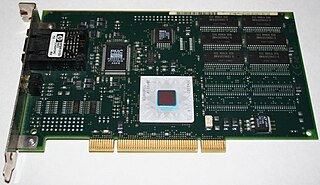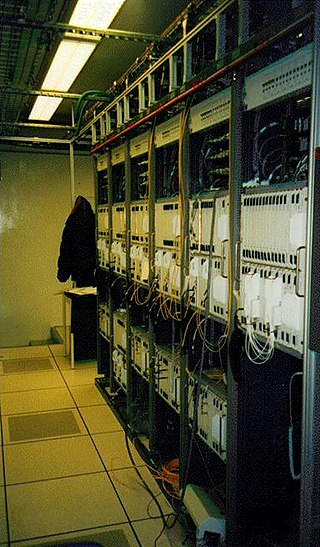Ethernet Over SDH (EoS or EoSDH) or Ethernet over SONET refers to a set of protocols which allow Ethernet traffic to be carried over synchronous digital hierarchy networks in an efficient and flexible way. The same functions are available using SONET.
Ethernet frames which are to be sent on the SDH link are sent through an "encapsulation" block (typically Generic Framing Procedure or GFP) to create a synchronous stream of data from the asynchronous Ethernet packets. The synchronous stream of encapsulated data is then passed through a mapping block which typically uses virtual concatenation (VCAT) to route the stream of bits over one or more SDH paths. As this is byte interleaved, it provides a better level of security compared to other mechanisms for Ethernet transport.[ citation needed ]
After traversing SDH paths, the traffic is processed in the reverse fashion: virtual concatenation path processing to recreate the original synchronous byte stream, followed by decapsulation to converting the synchronous data stream to an asynchronous stream of Ethernet frames.
The SDH paths may be VC-4, VC-3, VC-12 or VC-11 paths. Up to 64 VC-11 or VC-12 paths can be concatenated together to form a single larger virtually concatenated group. Up to 256 VC-3 or VC-4 paths can be concatenated together to form a single larger virtually concatenated group. The paths within a group are referred to as "members". A virtually concatenated group is typically referred to by the notation pathType-Xv, where pathType is VC-4, VC-3, VC-12 or VC-11 and X is the number of members in the group.
| Container (SDH) | Container (SONET) | Type | Payload Capacity (Mbit/s) |
|---|---|---|---|
| VC-11-Xv | VT-1.5-Xv SPE | Low Order | X x 1.600 (X = 1 to 64) |
| VC-12-Xv | VT-2-Xv SPE | Low Order | X x 2.176 (X = 1 to 64) |
| VC-2-Xv | - | Low Order | X x 6.848 (X = 1 to 64) |
| VC-3-Xv | STS-1-Xv SPE | High Order | X x 48.384 (X = 1 to 256) |
| VC-4-Xv | STS-3c-Xv SPE | High Order | X x 149.76 (X = 1 to 256) |
EoS also drops the "idle" packets of the Ethernet frame before encapsulating the Ethernet frame to GFP, which is recreated at the other end during decapsulation process. Hence this provide a better throughput compared to native Ethernet transport.
An additional protocol, called link capacity adjustment scheme (LCAS), allows the two endpoints of the SDH paths to negotiate which paths are working and can carry traffic versus which paths should not be used to carry traffic.

Asynchronous Transfer Mode (ATM) is a telecommunications standard defined by the American National Standards Institute and ITU-T for digital transmission of multiple types of traffic. ATM was developed to meet the needs of the Broadband Integrated Services Digital Network as defined in the late 1980s, and designed to integrate telecommunication networks. It can handle both traditional high-throughput data traffic and real-time, low-latency content such as telephony (voice) and video. ATM provides functionality that uses features of circuit switching and packet switching networks by using asynchronous time-division multiplexing. ATM was seen in the 1990s as a competitor to Ethernet and networks carrying IP traffic as it was faster and was designed with quality-of-service in mind, but it fell out of favor once Ethernet reached speeds of 1 gigabits per second.
Multiprotocol Label Switching (MPLS) is a routing technique in telecommunications networks that directs data from one node to the next based on labels rather than network addresses. Whereas network addresses identify endpoints, the labels identify established paths between endpoints. MPLS can encapsulate packets of various network protocols, hence the multiprotocol component of the name. MPLS supports a range of access technologies, including T1/E1, ATM, Frame Relay, and DSL.

Synchronous Optical Networking (SONET) and Synchronous Digital Hierarchy (SDH) are standardized protocols that transfer multiple digital bit streams synchronously over optical fiber using lasers or highly coherent light from light-emitting diodes (LEDs). At low transmission rates data can also be transferred via an electrical interface. The method was developed to replace the plesiochronous digital hierarchy (PDH) system for transporting large amounts of telephone calls and data traffic over the same fiber without the problems of synchronization.

Time-division multiplexing (TDM) is a method of transmitting and receiving independent signals over a common signal path by means of synchronized switches at each end of the transmission line so that each signal appears on the line only a fraction of time in an alternating pattern. It can be used when the bit rate of the transmission medium exceeds that of the signal to be transmitted. This form of signal multiplexing was developed in telecommunications for telegraphy systems in the late 19th century, but found its most common application in digital telephony in the second half of the 20th century.
The use of Asynchronous Transfer Mode (ATM) technology and services creates the need for an adaptation layer in order to support information transfer protocols, which are not based on ATM. This adaptation layer defines how to segment higher-layer packets into cells and the reassembly of these packets. Additionally, it defines how to handle various transmission aspects in the ATM layer.
In computer networking and telecommunications, a pseudowire is an emulation of a point-to-point connection over a packet-switched network (PSN).
Throughput of a network can be measured using various tools available on different platforms. This page explains the theory behind what these tools set out to measure and the issues regarding these measurements.
Resilient Packet Ring (RPR), as defined by IEEE standard 802.17, is a protocol designed for the transport of data traffic over optical fiber ring networks. The standard began development in November 2000 and has undergone several amendments since its initial standard was completed in June 2004. The amended standards are 802.17a through 802.17d, the last of which was adopted in May 2011. It is designed to provide the resilience found in SONET and Synchronous Digital Hierarchy networks but, instead of setting up circuit oriented connections, provides a packet based transmission, in order to increase the efficiency of Ethernet and IP services.
Packet over SONET/SDH, abbreviated POS, is a communications protocol for transmitting packets in the form of the Point to Point Protocol (PPP) over SDH or SONET, which are both standard protocols for communicating digital information using lasers or light emitting diodes (LEDs) over optical fibre at high line rates. POS is defined by RFC 2615 as PPP over SONET/SDH. PPP is the Point to Point Protocol that was designed as a standard method of communicating over point-to-point links. Since SONET/SDH uses point-to-point circuits, PPP is well suited for use over these links. Scrambling is performed during insertion of the PPP packets into the SONET/SDH frame to solve various security attacks including denial-of-service attacks and the imitation of SONET/SDH alarms. This modification was justified as cost-effective because the scrambling algorithm was already used by the standard used to transport ATM cells over SONET/SDH. However, scrambling can optionally be disabled to allow a node to be compatible with another node that uses the now obsoleted RFC 1619 version of Packet over SONET/SDH which lacks the scrambler.
In computer networking and telecommunications, TDM over IP (TDMoIP) is the emulation of time-division multiplexing (TDM) over a packet-switched network (PSN). TDM refers to a T1, E1, T3 or E3 signal, while the PSN is based either on IP or MPLS or on raw Ethernet. A related technology is circuit emulation, which enables transport of TDM traffic over cell-based (ATM) networks.
SPI-4.2 is a version of the System Packet Interface published by the Optical Internetworking Forum. It was designed to be used in systems that support OC-192 SONET interfaces and is sometimes used in 10 Gigabit Ethernet based systems.
Optical Carrier transmission rates are a standardized set of specifications of transmission bandwidth for digital signals that can be carried on Synchronous Optical Networking (SONET) fiber optic networks. Transmission rates are defined by rate of the bitstream of the digital signal and are designated by hyphenation of the acronym OC and an integer value of the multiple of the basic unit of rate, e.g., OC-48. The base unit is 51.84 Mbit/s. Thus, the speed of optical-carrier-classified lines labeled as OC-n is n × 51.84 Mbit/s.

A metropolitan-area Ethernet, Ethernet MAN, carrier Ethernet or metro Ethernet network is a metropolitan area network (MAN) that is based on Ethernet standards. It is commonly used to connect subscribers to a larger service network or for internet access. Businesses can also use metropolitan-area Ethernet to connect their own offices to each other.
Generic Framing Procedure (GFP) is a multiplexing technique defined by ITU-T G.7041. This allows mapping of variable length, higher-layer client signals over a circuit switched transport network like OTN, SDH/SONET or PDH. The client signals can be protocol data unit (PDU) oriented or can be block-code oriented.
Link Capacity Adjustment Scheme or LCAS is a method to dynamically increase or decrease the bandwidth of virtual concatenated containers. The LCAS protocol is specified in ITU-T G.7042.
Virtual concatenation (VCAT) is an inverse multiplexing technique creating a large capacity payload container distributed over multiple smaller capacity TDM signals. These signals may be transported or routed independently. Virtual concatenation has been defined for SONET/SDH, OTN and PDH path signals.
Provider Backbone Bridge Traffic Engineering (PBB-TE) is a computer networking technology specified in IEEE 802.1Qay, an amendment to the IEEE 802.1Q standard. PBB-TE adapts Ethernet to carrier class transport networks. It is based on the layered VLAN tags and MAC-in-MAC encapsulation defined in IEEE 802.1ah, but it differs from PBB in eliminating flooding, dynamically created forwarding tables, and spanning tree protocols. Compared to PBB and its predecessors, PBB-TE behaves more predictably and its behavior can be more easily controlled by the network operator, at the expense of requiring up-front connection configuration at each bridge along a forwarding path. PBB-TE Operations, Administration, and Management (OAM) is usually based on IEEE 802.1ag. It was initially based on Nortel's Provider Backbone Transport (PBT).
Ethernet over PDH or EoPDH is one of many techniques that provided Ethernet connectivity over non-Ethernet networks. Specifically, EoPDH is a standardized methodology for transporting native Ethernet frames over the existing telecommunications copper infrastructure by leveraging the established PDH transport technology. EoPDH is one of several Ethernet transport technologies that enables Telecommunication Service Providers to offer "Carrier Ethernet" services. Also commonly used as a means of connecting businesses to a Metro Ethernet network.

Ethernet over PDH over SONET/SDH (EoPoS) is one of many techniques that provided Ethernet connectivity over non-Ethernet networks. EoPoS is a standardized method for transporting native Ethernet frames over the existing telecommunications optical infrastructure use both the established Plesiochronous Digital Hierarchy (PDH) and Synchronous Digital Hierarchy (SONET/SDH) transport technologies.
The STM-4 is a SDH ITU-T fiber optic network transmission standard. It has a bit rate of 622.080 Mbit/s.